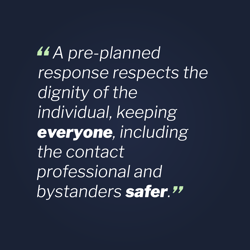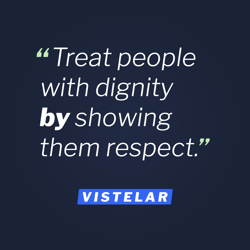When differences divide us, treating each other with dignity by showing respect establishes a common ground for managing conflict.
Security in healthcare environments begins with how people are treated. This sentiment seems self-evident and so commonplace that when we hear it, we give an obligatory nod of agreement. Such is the nature of a truism—obviously true and not that interesting. That said, how people are treated and how it relates to security and safety in healthcare is deserving of our attention. Afterall, the keys to treating people with dignity are directly relevant to maximizing security in healthcare.
A single truth makes this clear: Dignity is a universal human need.
Dignity is as basic as food, shelter and water. As such, it is vulnerable to injury when poor communication practices—threats, coercion, demands—are used in interactions where compliance, cooperation or collaboration are the intended communication goals. In virtually every discipline, whether it’s education, public safety, customer service, hospitality, security, or social services, the proper handling of a person’s dignity is always necessary and depends on the skill, ability and ultimately training of contact professionals.[1]
In other words, dignity is always in play. Like any need, it is either met or unmet. When the dignity needs of people are met, everyone is safer because conflict can be better managed or even avoided entirely.
When those needs are not met, conflict occurs, and safety and security are compromised. For instance, when a caseworker investigating an allegation of child neglect knocks on a door to make initial contact, if the dignity of the person who answers the door is violated, resistance will arise at the point of contact. In a scene like this, conflict often ramps up because the reason for the contact is delivered in an unclear and ambiguous way. If the person at the door asks for or demands clarification and that clarification is not forthcoming, ambiguity becomes indignity. This is just one example of how a person’s dignity can be injured or violated.
Be Mindful of How You React
In healthcare, where high-stakes encounters are routine, dignity moves in a fragile orbit around the many interactions that take place in the healthcare universe. For example,
- a man, unhappy with the care provided his spouse, comes back to the hospital highly agitated, wanting to express his anger and make a complaint. How this man’s agitation and anger is managed is, first and foremost, is a matter of how his dignity is handled. If a hospital employee approaches this man and says, “Hey! Calm down; you can’t act like that in here! There are other kids and families here,” his dignity will have been mishandled. His thought might be something like, Tell me to calm down? What about my family? Don’t tell me how to act; look how you treated my wife.
On the other hand, a hospital employee can enter the scene with the following pre-planned approach:
- Be alert to the individual’s level of agitation and body posturing
- Be decisive by utilizing a pre-planned practiced response
- Prepare their mindset by being aware of their personal feelings and biases
- Adjust their posture and managing their breathing, to increase their confidence
- Align their facial expression and body language to the situation
- Approach a potential conflict as a new challenge instead of just another problem with a difficult person
- Manage their distance and position (Proxemics 10-5-2),
- Observe at 10 feet and evaluate for signs of agitation, aggression, or emotional distress
- If safe, approach to 6 feet and begin communication, setting the tone for the encounter by saying, “Good afternoon, sir, My name is Marie. I work in security here at the hospital. The reason I approached you is that I noticed you seem pretty upset today. Can I ask you if we can go over there and talk a little more about what’s going on for you today? That way we can have some privacy so we’re not around all these people. How’s that sound, sir?”
These two approaches are worlds apart in terms of how people’s dignity is respected and managed. The first is reactive and suggests that the employee is bringing their personal biases and attitude into the interaction, almost guaranteeing indignity that results in friction, that could lead to agitation and possibly even violence.
The Benefits of a Pre-Planned Response
The second approach is responsive and suggests a pre-planned response that respects the dignity of the individual, keeping everyone, including the contact professional and bystanders safer.
individual, keeping everyone, including the contact professional and bystanders safer.
Other common healthcare scenarios illustrate situations where people’s dignity is on the line:
- A disgruntled patient, feeling his procedure was unsuccessful, comes back to the clinic wanting to talk to the doctor who performed the procedure.
- A family member in the ED is infuriated by the service his daughter is receiving, wants to talk to someone in authority and is told by staff to calm down and wait like everybody else.
When the contact professional skillfully preserves a person’s dignity in a high-stress interaction, the safety and security of all involved increases. Alternatively, mishandling emotionally intense situations can injure or violate the dignity of a patient or family member, leading to conflict that could end in violence. In fact, violence is not only more common in healthcare than in other industries, violence related injuries to healthcare workers account for almost as many similar injuries sustained by workers in all other industries combined.[2]
So, how do we build safety and security in the healthcare environment? The first step is to understand what we mean by this universal need we call dignity. The second step is to develop a sensitivity to the vulnerabilities or pressure points that trigger indignity. Because contact professionals are students of the human condition. they are naturally curious about what techniques successfully preserve a person’s dignity. As a result, they concern themselves with doing their best, doing no harm and improving safety and security in their encounters with people.
Let’s take a closer look at dignity, its pressure-points, and the skills, practices and behaviors that address these vulnerabilities.
What is Dignity?
Dignity is an acknowledgement of the inherent value we share as human beings. Dignity expresses itself as an irrepressible need—or a basic human need. In stating what is central to this value, Robert L. Humphrey, JD, author of Values for a New Millennium, frames this need in an elegant remark: [every person has an] irrepressible desire to be treated as an equal human being.
Dignity’s Pressure Points
If Humphrey gives a sense of the significance of a person’s need for dignity, Psychiatrist and author, Dr. Aaron Lazare suggests the pressure points that trigger indignity; he posits a number of self-conscious emotions[3] which represent vulnerabilities to a person’s sense of dignity. We will consider Shame and Humiliation because of their close association with violations of dignity in the healthcare environment.
Shame
Dr. Lazare notes that we carry an image of ourselves that symbolically serves as a covering or protection. As such, to be shamed, says Lazare, is to be uncovered—to be exposed to indignity in some way. The routine act of asking a patient to disrobe and put on that backless gown is an uncovering event that leaves a person in a one-down position. While shame, in this sense, tends to make a person want to protect themselves from further indignity, but it does not tend to drive a person to agitation or aggression in the same way that humiliation might (Lazare). Still, shame is an indignity. To address this indignity, we can create a sense of partnership. This happens when we practice
- asking rather than telling
- explaining rather that withholding information
Asking and explaining why is a strategy that treats people with dignity by showing them respect. When the possibility of shame exists, a strategic approach is crucial. The strategy of asking and explaining conveys respect, establishes partnership and tends to dismantle indignity. To illustrate, when we need someone to cooperate with an essential task (putting on the backless gown), asking shows respect and tactfully addresses the potential indignity of feeling uncovered. Next, explain why the task needs to be done in a way that assumes every patient needs the explanation because without the it, they would be confused or unclear about the reasons. Then offer strategies to reduce or avoid humiliation, such as another gown to cover the rear of a blanket, should always be offered when possible.
Humiliation
Humiliation is so emotionally potent, says Lazare, that they can be like having a person’s face, metaphorically, pushed into the ground. Humiliation is being stripped of dignity. We often speak of saving face and losing face in connection with humiliation.
Saving face in a health care context involves
- creating a listening context that sees the patient’s concerns through their eyes.
Losing face involves
- feeling ignored
- not being acknowledged
- not being heard, being interrupted or dismissed
- metaphorically, being pushed around.
Humiliation caused by poor communication may be inadvertent as lacking conflict management skills may seem benign. When professionals lack conflict management skills, we default to what we know or have experienced and that is not always good. For example, a professional might do something as seemingly harmless as employing either/or statements to gain cooperation from a patient while, at the same time, offering only negative consequences. These default methods are not harmless. Of course, they are not meant to humiliate or coerce, but they do so because someone in authority is doing something to someone that is both public and pushy. When this sort of thing happens to a person, several things can result:
- Disorientation—feeling blindsided
- Resentment–fixating on a perceived insult
- Rumination–about come-backs, retaliation, or revenge
- Anger and rage
Humiliation is a dangerous emotion; akin to a loss of honor, says Lazare.
The impact of humiliation debases our irrepressible desire to be treated as an equal human being. As noted, the human reaction to humiliation can be expressed in rage, aggression and violence.
A Proper Response Is Needed
Dignity is important to the process of managing conflict. We know dignity’s pressure points and vulnerabilities. We understand how devastating indignity is to the process of managing safety in high stress situations. We know that healthcare is a high-stress profession vulnerable to violent events committed by patients, family members, employees, and visitors.
Given all of this, a systematic and strategic approach is necessary to address these real-world actualities.
Vistelar, LLC, is a consulting and training institute focused on addressing the entire spectrum of human conflict at the point of impact—from before an interaction begins through to the consequences of how an interaction is managed. The Vistelar training system drills down on these and other key concepts
- Situational awareness
- Threat assessment
- Non-escalation
- De-escalation
- Non-violent & violent crisis intervention
- Personal protection
- Physical alternatives
In the above illustration of the agitated man, a small example of situational awareness, threat assessment and non-escalation strategies was presented.
The primary emphasis in this article is the same as Vistelar’s precision focus on the dignity factor—a principal pathway to safer interactions in healthcare and other disciplines.
Vistelar’s core principle of conflict management is fitting and timely:
Treat people with dignity by showing them respect
Why?
- It is the right thing to do
- It drives better results, better relationships, better performance and job satisfaction in high stress, emotionally intense, situations
- It makes gaining compliance and cooperation ethical rather than coercive
Treating people with respect requires proven strategies. Our intuitive “know-how” and life experience play a part in securing the cooperation and safety of a patient or family member, but intuitive feelings are usually unevenly applied. Proven methods are necessary for the kind of professional consistency that produces safer outcomes in high pressure contexts.
In order to treat people with dignity, people must learn the distinctive skills and behaviors associated with showing respect. Remember the principle?
Treat people with dignity by showing them respect.
How do people want to be shown respect? All people, regardless of race, religion, gender, sexual orientation or culture, want to be shown respect in these five distinctive ways:
SEE THE WORLD THROUGH THEIR EYES
Seeing the world through the other person’s eyes is called perspective taking—creating a listening context, acknowledging concern, seeking a deeper understanding and anticipating the person’s needs. Perspective taking is also empathy in action. These empathy elements are real-world ways to apply dignity:
Acknowledge perspective
For example: acknowledging the importance of a patient’s question, concern or dilemma, “That’s an important question. Let me see if I understand your concern. You’ve been waiting a long while and no one has tried to help you yet?”
Seek a deeper understanding
For example: reflect emotion by saying, “I can see that this is frustrating. What’s your biggest concern right now? Let’s talk about that first.” This demonstrates how you would want to be treated if you were in that person’s exact same circumstances.
Anticipate the other person’s needs
For example: respond to specific requests for information and clarification rather than dismissing or deferring such requests. Dismissiveness might say, “I can’t tell you that right now, but if you’ll calm down, we can talk.”
Anticipating a need might sound like a response to a specific question or concern. For example: “Thank you for asking me that. Let me see if I can explain this better and you can let me know how I did. How’s that sound?”
LISTEN WITH ALL YOUR SENSES
This involves more than hearing words. Listening with all senses is paying attention to another person’s physical and emotional experience. Real listening involves what you see, smell, and feel, while thinking about how you can adjust your response.
- Is the person agitated?
- Is speech rapid or slow?
- Is volume loud or is the person silent?
- What are the smells (smoker)?
- What can I see in the demeanor or affect–fear, anger, resignation?
- What can I tune into?
- How can I adjust my tone and volume?
- What kind of interest or concern can I show on my face to adjust to the person’s need for understanding or positive regard?
- What emotions can I reflect to show that I’m exploring the person’s challenging predicament?
Listening with all senses, as a way of being more acutely aware of the other, is a concrete way to treat with dignity by showing respect to another human being. Our goal is to notice the potential for indignity so we can have a positive impact.
ASK AND EXPLAIN WHY
Look for the opportunity to explain what you would like a person to do and why:
- Forecast what is going to happen next.
- Cultivate a mindset of over communicating.
- Assume the patient or family member may be confused or unclear about processes and procedures.
Example:
“I noticed you’ve been waiting for a long time and that’s caused some frustration. We’ve been having one of our busier nights. Your wait time at this point might be another 20 minutes, and I’ll keep you posted. In the meantime, I’d like to ask you to let me help you find a place to have a seat and be more comfortable.”
OFFER OPTIONS, LET THEM CHOOSE
Explaining why should include invitations to make choices. People want to feel empowered to make their own decisions, even when they include expectations for behavior. Look for ways to give people a couple of options from which to choose, rather than just a single choice or an either/or ultimatum. You might consider the formula of positive option first—slow down the contact—negative option next—end with a positive option—let them choose. Wouldn’t you rather have conversations involving the power of choice, than confrontations involving demands?
Example of Offering Options:
“Would you rather I mail you the paperwork to complete in advance of your visit, or would you like to arrive early so you can complete the paperwork at the time of your visit?”
GIVE OPPORTUNITY TO RECONSIDER
Occasions when we are trying to manage conflict can quickly devolve into ‘this is your last chance’ scenarios. We want to avoid such power struggles, as they only intensify conflict that can lead to hostility and even violence. We all make mistakes, especially under pressure. We want to be able to offer people an opportunity to reconsider their resistance or poor choices.
We talked about saving face earlier. The opportunity to reconsider is a face-saving act that allows a person the opportunity for another chance.
Example:
“Is there anything I could say right now to gain your cooperation so we can sit down and talk more about this? I would appreciate that.”
Or
“We obviously got off on the wrong foot with each other. I’d like to start over so we can work this out.”
Vistelar’s vision is to make the world safer by teaching everyone how to treat each other with dignity by showing respect through learnable skills and behaviors.
Email: info@vistelar.com Visit: http://www.vistelar.com
To learn more: Call: 877-690-8230
[1] Contact Professional is a trademarked phrase by Vistelar LL. The phrase defines individuals who spend most of their time directly interacting with the general public and their organization’s clients, including healthcare and social services workers, police and security officers, educators, retail and hospitality workers and transit workers.
[2] ECRI Institute: Violence in Healthcare Facilities. Healthcare Risk Control. May 2017.
[3] Safe Space Radio Series, Hidden Emotions, May 18, 2015 (Interview with Dr. Aaron Lazare). https://content.blubrry.com/safespaceradio/206046130-dr-anne-hidden-emotions.mp3








